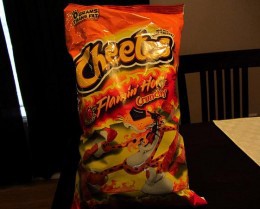Food Stamps, Obesity, and Hunger in the Rio Grande Valley

In the Rio Grande Valley in South Texas, poverty rates are high and people are hungry, yet 38.5 percent of the residents there are considered obese. Part of this reason, according to this feature by Eli Saslow in The Washington Post (Saslow’s fifth story in this series), is because food stamps can be used to buy junk food at many convenience stores, which sell lots of processed, or fried food, and a $1 snack I hadn’t heard about until now: a bag of Flamin’ Hot Cheetos with hot cheese poured over it.
Terry Canales, a 33-year-old Texas state representative who grew up surrounded by poverty and obesity, concluded that “we are slowly killing ourselves,” and decided to introduce a bill that he thought could do a small part to counteract this:
Instead of trying to regulate the estimated $2 billion in junk-food purchases enabled each year by food stamps, he wrote a bill to ban the food-stamp purchase of only one product. That was energy drinks — high in caffeine and higher in sugar, expensive and marketed to children despite offering little nutritional value.
“A no-brainer,” he explained as he introduced the bill in a committee meeting last summer.
Then he yielded the microphone and waited for rebuttals.
The rebuttals came from everyone: a lobbyist for the Texas Beverage Association (for obvious reasons), but also representatives from food banks, anti-hunger groups, and lawmakers from both sides of the aisle. The reasons were plentiful: Why ban one unhealthy product, but leave so many others available? Should the government be able to tell people what they should eat? Shouldn’t lawmakers use their time and energy to figure out how to eradicate poverty instead of regulate them? Or what about making the street safer so people could exercise? How about putting funding into nutrition education programs, and getting more fresh produce into inner-city grocery stores?
The last point is especially important. Saslow follows two nutrition educators as they go through low-income communities to enroll women in nutrition classes. One woman explained that the closest grocery store with fresh produce was seven miles away and that people didn’t really venture out after 4 p.m. because of the drug cartels in the area. She also didn’t own a refrigerator, which meant processed food would keep longer than fresh food would. The answer to how to help people on food stamps eat better is a difficult one to address.
Photo: Calgary Reviews
Support The Billfold
The Billfold continues to exist thanks to support from our readers. Help us continue to do our work by making a monthly pledge on Patreon or a one-time-only contribution through PayPal.
Comments